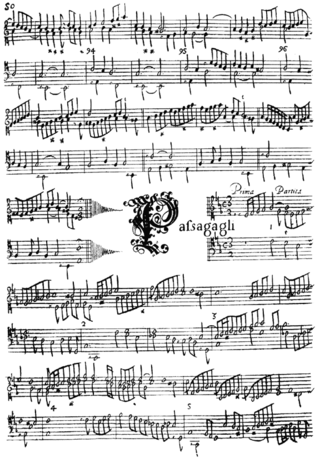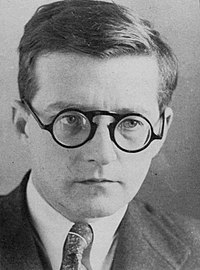
Dmitri Dmitriyevich Shostakovich was a Soviet-era Russian composer and pianist who became internationally known after the premiere of his First Symphony in 1926 and thereafter was regarded as a major composer.

The passacaglia is a musical form that originated in early seventeenth-century Spain and is still used today by composers. It is usually of a serious character and is typically based on a bass-ostinato and written in triple metre.
Dmitri Shostakovich's String Quartet No. 8 in C minor, Op. 110, was written in three days.
The Symphony No. 5 in D minor, Op. 47, by Dmitri Shostakovich is a work for orchestra composed between April and July 1937. Its first performance was on November 21, 1937, in Leningrad by the Leningrad Philharmonic Orchestra under Yevgeny Mravinsky. The premiere was a "triumphal success" that appealed to both the public and official critics, receiving an ovation that lasted well over half an hour.
The Symphony No. 10 in E minor, Op. 93, by Dmitri Shostakovich was premiered by the Leningrad Philharmonic Orchestra under Yevgeny Mravinsky on 17 December 1953. It is not clear when it was written. According to the composer, the symphony was composed between July and October 1953, but Tatiana Nikolayeva stated that it was completed in 1951. Sketches for some of the material date from 1946.
The Violin Concerto No. 1 in A minor, Op. 77, was originally composed by Dmitri Shostakovich in 1947–48. He was still working on the piece at the time of the Zhdanov Doctrine, and it could not be performed in the period following the composer's denunciation. In the time between the work's initial completion and the first performance, the composer, sometimes with the collaboration of its dedicatee, David Oistrakh, worked on several revisions. The concerto was finally premiered by the Leningrad Philharmonic under Yevgeny Mravinsky on 29 October 1955. It was well-received, Oistrakh remarking on the "depth of its artistic content" and describing the violin part as a "pithy 'Shakespearian' role."
Ivan Ivanovich Sollertinsky was a Soviet polymath. He specialized in fields including linguistics, theatre, literature, history, and philology, but was most known for his work in the musical field as a critic and musicologist. He was a professor at the Leningrad Conservatory, as well as an artistic director of the Leningrad Philharmonic, and a prominent orator. In these capacities, he was an active promoter of Mahler's music in the Soviet Union. Sollertinsky was also interested in ballet and often wrote essays on the subject during the 1930s, along with teaching ballet history at the Leningrad Choreographic Institute. According to contemporaries – most famously Irakly Andronikov – he had a phenomenal memory, and supposedly spoke 26 languages and 100 dialects. However, Nikolai Malko claimed that Sollertinsky was able to speak 32 languages, some of which were also considered dialects.
E major is a major scale based on E, consisting of the pitches E, F♯, G♯, A, B, C♯, and D♯. Its key signature has four sharps. Its relative minor is C-sharp minor and its parallel minor is E minor. Its enharmonic equivalent, F-flat major, has six flats and the double-flat B, which makes that key less convenient to use.
E-flat major is a major scale based on E♭, consisting of the pitches E♭, F, G, A♭, B♭, C, and D. Its key signature has three flats. Its relative minor is C minor, and its parallel minor is E♭ minor,.

Piano Concerto No. 2 in F major, Op. 102, by Dmitri Shostakovich was composed in 1957 for the 19th birthday of his son Maxim, who premiered the piece during his graduation concert at the Moscow Conservatory. It contains many similar elements to Shostakovich's Concertino for Two Pianos: both works were written to be accessible for developing young pianists. It is an uncharacteristically cheerful piece, much more so than most of Shostakovich's works.

Dmitri Shostakovich's String Quartet No. 10 in A-flat major, Op. 118, was composed from 9 to 20 July 1964. It was premiered by the Beethoven Quartet in Moscow and is dedicated to composer Mieczysław (Moisei) Weinberg, a close friend of Shostakovich. It has been described as cultivating the uncertain mood of his earlier Stalin-era quartets, as well as foreshadowing the austerity and emotional distance of his later works. The quartet typified the preference for chamber music over large scale works, such as symphonies, that characterised his late period. According to musicologist Richard Taruskin, this made him the first Russian composer to devote so much time to the string quartet medium.
DSCH is a musical motif used by the composer Dmitri Shostakovich to represent himself. It is a musical cryptogram in the manner of the BACH motif, consisting of the notes D, E-flat, C, B natural, or in German musical notation D, Es, C, H, thus standing for the composer's initials in German transliteration: D. Sch..

Children's Notebook, also known as A Child's Exercise Book, Op. 69 is a suite for piano composed by Dmitri Shostakovich. Although precise dating is uncertain, it is believed to have been composed over a period of twelve to eighteen months between 1944 and 1945. Shostakovich intended it for his daughter, Galina, who at the time was a young child beginning her piano studies. Originally envisioned as a cycle of twenty-four pieces in all keys arranged along a circle of fifths, the completed work ultimately contained only seven. Each piece included a corresponding illustration by Pyotr Williams.
The Concerto in C minor for Piano, Trumpet, and String Orchestra, Op. 35, was completed by Dmitri Shostakovich in 1933.

The Piano Sonata No. 2 in B minor, Op. 61 by Dmitri Shostakovich, the last of his piano sonatas, was composed in early 1943. It was his first solo piano composition since 1933, as well as his second attempt at composing a piano sonata in the key of B minor.

Dmitri Shostakovich composed his Sonata for Violin and Piano in G major, Op. 134 in the autumn of 1968 in Moscow, completing it on October 23. It is set in three movements and lasts approximately 31 minutes. It is dedicated to the violinist David Oistrakh, who premiered the work on May 3, 1969 in the Large Hall of the Moscow Conservatory.
The Sonata for Viola and Piano, Op. 147, is the last composition by Dmitri Shostakovich. It was completed on July 5, 1975, weeks before his death. It is dedicated to Fyodor Druzhinin, violist of the Beethoven Quartet.

The 24 Preludes, Op. 34 is a set of short piano pieces written and premiered by Dmitri Shostakovich in 1933. They are arranged following the circle of fifths, with one prelude in each major and minor key.
Scherzo in F-sharp minor is a piece for orchestra written by Dmitri Shostakovich (1906–1975). Shostakovich was a Russian composer and pianist during the Soviet era. It was most likely written in 1921 or 1922 while Shostakovich was studying at the Petrograd Conservatory under Maximilian Steinberg. The composition is one of the composer's earliest surviving works. Originally written as a single movement of a piano sonata, the Scherzo was later orchestrated with assistance from Steinberg and became an orchestral work in its own right.






